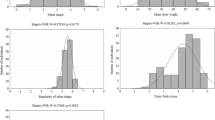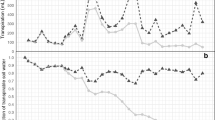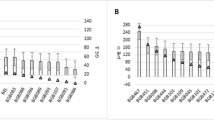Abstract
The objective of this paper is to evaluate the performance of the conventional system of classifying maturity type in potato and to provide a concept of maturity type based on crop physiology. We present an approach in which physiological traits are used to quantify and assess maturity type unambiguously for a set of varieties covering a wide range of maturity classes and a diploid F1 population separating for maturity and well-adapted to Dutch growing conditions, both grown in six environments. We defined physiological maturity based on four traits: the duration of maximum green canopy, the area under the green canopy cover progress curve, and the rate and duration of tuber bulking. The results indicated that physiological maturity type criteria tended to define maturity classes less ambiguously than the conventional criterion. Moreover, the conventional criterion was subject to more random noise and lacked stability and/or repeatability compared with the physiological traits. The physiological maturity criteria also illustrated the physiological trade-offs that existed between the selected traits and underlined the subtle complexities in classifying maturity type. This study highlighted the capabilities of different maturity type criteria in discriminating between different maturity classes among the large set of genotypes. Our new approach involving key physiological traits could be beneficial in offering physiology-based criteria to re-define maturity type. An improved criterion based on important physiological traits would allow relating the maturity to crop phenology and physiology. These new criteria may be amenable to further genetic analysis and could help in designing strategies for potato ideotype breeding for genotypes with specific maturity types.










Similar content being viewed by others
References
Almekinders CJM, Struik PC (1996) Shoot development and flowering in potato (Solanum tuberosum L.). Potato Res 39:581–607
Arshad M, Ali N, Ghafoor A (2006) Character correlation and path coefficient in soybean Glycine max (L.) Merrill. Pakistan J Bot 38:121–130
Beukema HP, van der Zaag DE (1979) Potato improvement. Some factors and facts. International Agriculture Centre, Wageningen
Bhatt GM (1972) Significance of path coefficient analysis in determining the nature of character association. Euphytica 22:338–343
Bodlaender KBA, Reestman AJ (1968) The interaction of nitrogen supply and plant density in potatoes. Neth J Agric Sci 16:165–176
Bond BJ (2000) Age-related changes in photosynthesis of woody plants. Trends Plant Sci 5:349–353
Burstall L, Harris PM (1983) The estimation of percentage light interception from leaf area index and percentage ground cover in potatoes. J Agric Sci 100:241–244
Burton WG, Wilson AR (1970) The apparent effect of the latitude of the place of cultivation upon the sugar content of potatoes grown in Great Britain. Potato Res 13:269–283
Dewey DR, Lu KH (1959) A correlation and path-coefficient analysis of components crested wheat grass seed production. Agron J 51:515–518
Dunemann F, Kahnau R, Schmidt H (1994) Genetic relationships in Malus evaluated by RAPD ‘fingerprinting’ of cultivars and wild species. Plant Breeding 113:150–159
Fleisher DH, Timlin DJ (2006) Modeling expansion of individual leaves in the potato canopy. Agric Forest Meteorol 139:84–93
Fleisher DH, Shillito RM, Timlin DJ, Kim S-H Reddy VR (2006) Approaches to modeling potato leaf appearance rate. Agron J 98:522–528
Goudriaan J, Monteith JL (1990) A mathematical function for crop growth based on light interception and leaf area expansion. Ann Bot 66:695–701
Grevsen K (2003) Weed competitive ability of green peas (Pisum sativum L.) affected by seeding rate and genotype characteristics. Biol Agric Hort 21:247–261
Haga E, Weber B, Jansky S (2012) Examination of potential measures of vine maturity in potato. Am J Plant Sci 3:495–505
Halderson JL, Haderlie LC, Corsini DL (1985) Potato vine kill: pulling, chemical killing and rolling effects on yield and quality of Russet Burbank. Am Potato J 62:281–288
Haverkort AJ, Kooman PL (1997) The use of systems analysis and modelling of growth and development in potato ideotyping under conditions affecting yields. Euphytica 94:191–200
Joenje W, Kropff MJ (1987) Relative time of emergence, leaf area development and plant height as major factors in crop–weed competition. British Crop Protection Conference, British Crop Protection Council, Brighton, pp 971–978
Khan MS (2012) Assessing genetic variation in growth and development of potato. PhD Thesis, Wageningen University, Wageningen
Kooman PL, Rabbinge R (1996) An analysis of the relation between dry matter allocation to the tuber and earliness of a potato crop. Ann Bot 77:235–242
Lotz L, Groeneveld RMV, De Groot N (1991) Potential for reducing herbicide inputs in sugar beet by selecting early closing cultivars. Proceedings Brighton Crop Protection Conference—Weeds, British Crop Protection Council, Brighton, UK, pp 1241–1248
McMaster GS, Wilhelm WW (1997) Growing degree-days: one equation, two interpretations. Agric Forest Meteorol 87:291–300
Netherlands Potato Consultative Foundation (NIVAP) (2007) Netherlands Catalogue of Potato Varieties. NIVAP, The Hague, 288 pp
Payne RW, Murray DA, Harding SA, Baird DB, Soutar DM (2009) GenStat for Windows (12th edn). Introduction. VSN International, Hemel Hempstead
Piluzza G, Pecetti L, Bullitta S, Piano E (2005) Discrimination among subterranean clover (Trifolium subterraneum L. complex) genotypes using RAPD markers. Genet Resour Crop Evol 52:193–199
Ram SG, Parthiban KT, Kumar RS, Thiruvengadam V, Paramathma M (2008) Genetic diversity among Jatropha species as revealed by RAPD markers. Genet Resour Crop Evol 55:803–809
Rouppe van der Voort J, Wolters JP, Folkertsma R, Hutten R, Van Zandvoort P, Vinke H, Kanyuka K, Bendahmane A, Jacobsen E, Janssen R, Bakker J (1997) Mapping of the cyst nematode resistance locus Gpa2 in potato using a strategy based on comigrating AFLP markers. Theor Appl Genet 95:874–880
SAS Institute Inc. (2004) SAS 9.1.3 help and documentation. SAS Institute, Cary
Struik PC (2010) Can physiology help us to combat late blight in potato? Potato Res 53:277–287
Struik PC, Ewing EE (1995) Crop physiology of potato (Solanum tuberosum): responses to photoperiod and temperature relevant to crop modelling. In: Haverkort AJ, MacKerron DKL (eds) Ecology and modelling of potato crops under conditions limiting growth. Kluwer Academic, Dordrecht, pp 19–40
Struik PC, Visker MHPW, Pauwels JB, Colon LT (2005) Are cuttings suitable for assessing maturity type in potato (Solanum tuberosum)? Ann Appl Biol 147:27–34
Van der Wal AF, Bouma WF, Huijsman CA, Maris B, Van Suchtelen NJ, Wiersema HT (1978) Breeding to maximize the physiological potential of potatoes for yield. Survey Papers 7th Triennial Conference EAPR, Warsaw, pp 23–33
Van Oijen M (1991) Light use efficiencies of potato cultivars with late blight (Phytophthora infestans). Potato Res 34:123–132
Van Os H, Andrzejewski S, Bakker E, Barrena I, Bryan GJ, Caromel B, Ghareeb B, Isidore E, De Jong W, Van Koert P, Lefebvre V, Milbourne D, Ritter E, Rouppe van der Voort JNAM, Rousselle-Bourgeois F, Van Vliet J, Waugh R, Visser RGF, Bakker J, Van Eck HJ (2006) Construction of a 10,000-marker ultradense genetic recombination map of potato: providing a framework for accelerated gene isolation and a genome wide physical map. Genetics 173:1075–1087
Vos J (1995a) Foliar development of the potato plant and modulations by environmental factors. In: Kabat P, van den Broek BJ, Marshall B, Vos J (eds) Modelling and parameterization of the soil–plant–atmosphere system. A comparison of potato growth models. Wageningen Pers, Wageningen, pp 21–38
Vos J (1995b) Potato ecology and modelling of crops under conditions limiting growth. In: Haverkort AJ, MacKerron DKL (eds) Current issues in production ecology. Kluwer Academic, Dordrecht
Vos J (2009) Nitrogen responses and nitrogen management in potato. Potato Res 52:305–317
Vos J, Biemond H (1992) Effects of nitrogen on the development and growth of the potato plant: I. Leaf appearance, expansion growth, life spans of leaves and stem branching. Ann Bot 70:27–35
Williams MM II, Boydston RA, Davis AS (2008) Crop competitive ability contributes to herbicide performance in sweet corn. Weed Res 48:58–67
Yin X, Kropff MJ (1996) Use of the Beta function to quantify effects of photoperiod on flowering and leaf number in rice. Agric For Meteorol 81:217–228
Yin X, Kropff MJ, McLaren G, Visperas RM (1995) A nonlinear model for crop development as a function of temperature. Agric Forest Meteorol 77:1–16
Yin X, Goudriaan J, Lantinga EA, Vos J, Spiertz JHJ (2003) A flexible sigmoid function of determinate growth. Ann Bot 91:361–371
Yin X, Struik PC, Tang J, Qi C, Liu T (2005) Model analysis of flowering phenology in recombinant inbred lines of barley. J Exp Bot 56:959–965
Yin X, Guo W, Spiertz JHJ (2009) A quantitative approach to characterize sink-source relationships during grain filling in contrasting wheat genotypes. Field Crops Res 114:119–126
Acknowledgments
The authors gratefully acknowledge funding from the European Community financial participation under the Seventh Framework Programme for Research, Technological Development and Demonstration Activities, for the Integrated Project NUE-CROPS FP7-CP-IP 222645. The views expressed in this publication are the sole responsibility of the author(s) and do not necessarily reflect the views of the European Commission. Neither the European Commission nor any person acting on behalf of the Commission is responsible for the use which might be made of the information contained herein. M.S.K. was supported by a grant of the Higher Education Commission (HEC), Government of Pakistan. We are grateful to the assistance and support of the Netherlands Organization for International Cooperation in Higher Education (NUFFIC).
Author information
Authors and Affiliations
Corresponding author
Rights and permissions
About this article
Cite this article
Khan, M.S., van Eck, H.J. & Struik, P.C. Model-Based Evaluation of Maturity Type of Potato Using a Diverse Set of Standard Cultivars and a Segregating Diploid Population. Potato Res. 56, 127–146 (2013). https://doi.org/10.1007/s11540-013-9235-z
Received:
Accepted:
Published:
Issue Date:
DOI: https://doi.org/10.1007/s11540-013-9235-z




